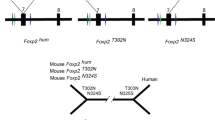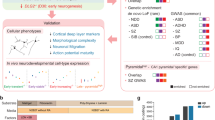Abstract
The signalling pathways controlling both the evolution and development of language in the human brain remain unknown. So far, the transcription factor FOXP2 (forkhead box P2) is the only gene implicated in Mendelian forms of human speech and language dysfunction1,2,3. It has been proposed that the amino acid composition in the human variant of FOXP2 has undergone accelerated evolution, and this two-amino-acid change occurred around the time of language emergence in humans4,5. However, this remains controversial, and whether the acquisition of these amino acids in human FOXP2 has any functional consequence in human neurons remains untested. Here we demonstrate that these two human-specific amino acids alter FOXP2 function by conferring differential transcriptional regulation in vitro. We extend these observations in vivo to human and chimpanzee brain, and use network analysis to identify novel relationships among the differentially expressed genes. These data provide experimental support for the functional relevance of changes in FOXP2 that occur on the human lineage, highlighting specific pathways with direct consequences for human brain development and disease in the central nervous system (CNS). Because FOXP2 has an important role in speech and language in humans, the identified targets may have a critical function in the development and evolution of language circuitry in humans.
This is a preview of subscription content, access via your institution
Access options
Subscribe to this journal
Receive 51 print issues and online access
$199.00 per year
only $3.90 per issue
Buy this article
- Purchase on Springer Link
- Instant access to full article PDF
Prices may be subject to local taxes which are calculated during checkout



Similar content being viewed by others
Accession codes
Primary accessions
Gene Expression Omnibus
Data deposits
Gene expression data have been deposited in the NCBI Gene Expression Omnibus (GEO; http://www.ncbi.nlm.nih.gov/geo) and are accessible using GEO series accession number GSE18142.
References
Feuk, L. et al. Absence of a paternally inherited FOXP2 gene in developmental verbal dyspraxia. Am. J. Hum. Genet. 79, 965–972 (2006)
Lai, C. S., Fisher, S. E., Hurst, J. A., Vargha-Khadem, F. & Monaco, A. P. A forkhead-domain gene is mutated in a severe speech and language disorder. Nature 413, 519–523 (2001)
MacDermot, K. D. et al. Identification of FOXP2 truncation as a novel cause of developmental speech and language deficits. Am. J. Hum. Genet. 76, 1074–1080 (2005)
Enard, W. et al. Molecular evolution of FOXP2, a gene involved in speech and language. Nature 418, 869–872 (2002)
Zhang, J., Webb, D. M. & Podlaha, O. Accelerated protein evolution and origins of human-specific features: Foxp2 as an example. Genetics 162, 1825–1835 (2002)
Spiteri, E. et al. Identification of the transcriptional targets of FOXP2, a gene linked to speech and language, in developing human brain. Am. J. Hum. Genet. 81, 1144–1157 (2007)
Vernes, S. C. et al. High-throughput analysis of promoter occupancy reveals direct neural targets of FOXP2, a gene mutated in speech and language disorders. Am. J. Hum. Genet. 81, 1232–1250 (2007)
Li, S., Weidenfeld, J. & Morrisey, E. E. Transcriptional and DNA binding activity of the Foxp1/2/4 family is modulated by heterotypic and homotypic protein interactions. Mol. Cell. Biol. 24, 809–822 (2004)
Oldham, M. C. et al. Functional organization of the transcriptome in human brain. Nature Neurosci. 11, 1271–1282 (2008)
Zhang, B. & Horvath, S. A general framework for weighted gene co-expression network analysis. Stat. Appl. Genet. Mol. Biol. 4, 17 (2005)
Acampora, D. et al. Craniofacial, vestibular and bone defects in mice lacking the Distal-less-related gene Dlx5. Development 126, 3795–3809 (1999)
Yoshihara, M., Adolfsen, B., Galle, K. T. & Littleton, J. T. Retrograde signaling by Syt 4 induces presynaptic release and synapse-specific growth. Science 310, 858–863 (2005)
Brusse, E. et al. Spinocerebellar ataxia associated with a mutation in the fibroblast growth factor 14 gene (SCA27): A new phenotype. Mov. Disord. 21, 396–401 (2006)
Holmes, S. E. et al. Expansion of a novel CAG trinucleotide repeat in the 5′ region of PPP2R2B is associated with SCA12. Nature Genet. 23, 391–392 (1999)
Belton, E., Salmond, C. H., Watkins, K. E., Vargha-Khadem, F. & Gadian, D. G. Bilateral brain abnormalities associated with dominantly inherited verbal and orofacial dyspraxia. Hum. Brain Mapp. 18, 194–200 (2003)
Shu, W. et al. Altered ultrasonic vocalization in mice with a disruption in the Foxp2 gene. Proc. Natl Acad. Sci. USA 102, 9643–9648 (2005)
Van Camp, G. et al. A new autosomal recessive form of Stickler syndrome is caused by a mutation in the COL9A1 gene. Am. J. Hum. Genet. 79, 449–457 (2006)
Uhlenberg, B. et al. Mutations in the gene encoding gap junction protein α12 (connexin 46.6) cause Pelizaeus-Merzbacher-like disease. Am. J. Hum. Genet. 75, 251–260 (2004)
Johnson, M. B. et al. Functional and evolutionary insights into human brain development through global transcriptome analysis. Neuron 62, 494–509 (2009)
Prabhakar, S., Noonan, J. P., Paabo, S. & Rubin, E. M. Accelerated evolution of conserved noncoding sequences in humans. Science 314, 786 (2006)
Dorus, S. et al. Accelerated evolution of nervous system genes in the origin of Homo sapiens. Cell 119, 1027–1040 (2004)
Enard, W. et al. A humanized version of Foxp2 affects cortico-basal ganglia circuits in mice. Cell 137, 961–971 (2009)
Kumar, S. & Hedges, S. B. A molecular timescale for vertebrate evolution. Nature 392, 917–920 (1998)
King, M. C. & Wilson, A. C. Evolution at two levels in humans and chimpanzees. Science 188, 107–116 (1975)
Enard, W. et al. Intra- and interspecific variation in primate gene expression patterns. Science 296, 340–343 (2002)
Caceres, M. et al. Elevated gene expression levels distinguish human from non-human primate brains. Proc. Natl Acad. Sci. USA 100, 13030–13035 (2003)
Coppola, G. et al. Gene expression study on peripheral blood identifies progranulin mutations. Ann. Neurol. 64, 92–96 (2008)
Konopka, G., Tekiela, J., Iverson, M., Wells, C. & Duncan, S. A. Junctional adhesion molecule-A is critical for the formation of pseudocanaliculi and modulates E-cadherin expression in hepatic cells. J. Biol. Chem. 282, 28137–28148 (2007)
Wohlschlegel, J. A. Identification of SUMO-conjugated proteins and their SUMO attachment sites using proteomic mass spectrometry. Methods Mol. Biol. 497, 33–49 (2009)
Elias, J. E. & Gygi, S. P. Target-decoy search strategy for increased confidence in large-scale protein identifications by mass spectrometry. Nature Methods 4, 207–214 (2007)
Coppola, G., Winden, K., Konopka, G., Gao, F. & Geschwind, D. H. Expression and network analysis of Illumina microarray data. Nature Protocols 10.1038/nprot.2009.215 (2009)
Acknowledgements
We thank M. Oldham for generating the Illumina microarray mask file; J. Ou and E. Spiteri for performing site-directed mutagenesis; L. Chen for technical assistance; and L. Kawaguchi for laboratory management. Human tissue was obtained from the NICHD Brain and Tissue Bank for Developmental Disorders at the University of Maryland (NICHD Contract numbers N01-HD-4-3368 and N01-HD-4-3383). The role of the NICHD Brain and Tissue Bank is to distribute tissue, and therefore cannot endorse the studies performed or the interpretation of results. This work was supported by grant R21MH075028, R37MH60233-06A1 (D.H.G.), T32HD007032, an A.P. Giannini Foundation Medical Research Fellowship, and a NARSAD Young Investigator Award (G.K.), T32MH073526 (K.W.) NIH/NCRR grant RR00165 and a James S. McDonnell Foundation grant, JSMF 21002093 (T.M.P).
Author Contributions G.K. and D.H.G. designed the study, analysed the data and wrote the paper; G.K. performed all of the experiments; J.M.B. made contributions to an earlier phase of the project including generating cell lines, immunoblotting and qRT–PCR; K.W. performed statistical analysis and weighted gene coexpression network analysis; G.C. conducted promoter analysis and G.C. and F.G. analysed the microarray data; Z.O.J. and J.A.W. performed mass spectrometry; S.P. performed some of the qRT–PCR; T.M.P. performed tissue dissections and provided non-human primate samples; all authors discussed the results and commented on the manuscript.
Author information
Authors and Affiliations
Corresponding authors
Supplementary information
Supplementary Information
This file contains Supplementary Figures 1-6 with Legends and Supplementary Tables 1-10. (PDF 882 kb)
Rights and permissions
About this article
Cite this article
Konopka, G., Bomar, J., Winden, K. et al. Human-specific transcriptional regulation of CNS development genes by FOXP2. Nature 462, 213–217 (2009). https://doi.org/10.1038/nature08549
Received:
Accepted:
Issue Date:
DOI: https://doi.org/10.1038/nature08549
This article is cited by
-
Possible roles of deep cortical neurons and oligodendrocytes in the neural basis of human sociality
Anatomical Science International (2024)
-
Biolinguistics and biological systems: a complex systems analysis of language
Biology & Philosophy (2023)
-
Investigation of Genetic Polymorphism in Autism Spectrum Disorder: a Pathogenesis of the Neurodevelopmental Disorder
Advances in Neurodevelopmental Disorders (2022)
-
Neanderthal, Sapiens, and chimpanzee mandibles: a comparative study in relation to articulated speech
Archaeological and Anthropological Sciences (2022)
-
Extracellular LGALS3BP regulates neural progenitor position and relates to human cortical complexity
Nature Communications (2021)
Comments
By submitting a comment you agree to abide by our Terms and Community Guidelines. If you find something abusive or that does not comply with our terms or guidelines please flag it as inappropriate.



